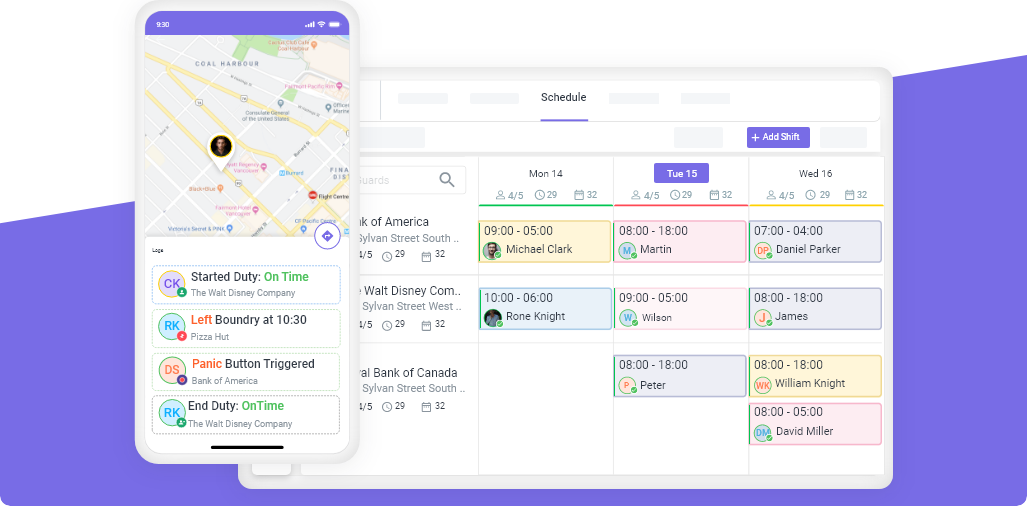Optimizing Workforce Management: A Comprehensive Guide for Efficiency and Productivity
Wed, May 24, 2023
Read in 8 minutes
It’s no mystery that the workforce is the backbone of any organization. They are the ones running the operations and are the face of your organization. When a company grows, so do the responsibilities and workforce. It becomes quite difficult to manage the workforce if you do not use the technologies at your disposal.

But Why Is Workforce Management System Needed?
The workforce management system is needed to effectively manage and optimize a company’s workforce, which is essential for achieving operational efficiency, productivity, and profitability. Here are some reasons why a workforce management system is necessary:
A workforce management system enables businesses to schedule their workforce efficiently, ensuring that the right people with the appropriate skills are available when needed. This can lead to reduced labor costs and increased productivity.
A workforce management system provides accurate and reliable time tracking, which is critical for payroll and compliance purposes. This can help businesses avoid compliance issues, reduce the risk of errors, and ensure that employees are paid accurately.
- Improved resource allocation:
By tracking employee performance and productivity, a workforce management system can help businesses allocate resources more effectively, ensuring that they have the right number of staff members in each department.
A workforce management system can improve employee engagement by providing employees with more control over their schedules and giving them greater visibility into their performance metrics.
- Better decision-making:
With real-time data and analytics, a workforce management system can help businesses make informed decisions regarding their workforce, including hiring, training, and retention. This can lead to a more agile and responsive workforce that can adapt to changing business needs.
Overall, a workforce management system is essential for businesses that want to optimize their workforce, improve productivity, and reduce costs.
What Are The Types Of Workforce Management?
In the security and cleaning industry, there are various types of workforce management strategies that can be employed to optimize productivity, efficiency, and overall business performance. Some of the common types of workforce management in this industry include:
- Shift schedule:
This involves creating and managing employee schedules to ensure that there is adequate coverage at all times. It may also involve tracking attendance and managing absences to ensure that the workforce is utilized efficiently.
- Time and attendance tracking:
This involves tracking employee time and attendance to ensure that they are working the hours they are scheduled to work. This can help to identify potential issues with attendance and ensure that employees are paid accurately.
- Performance management:
This involves monitoring employee performance and providing feedback to help employees improve their performance. This may involve setting performance goals, conducting performance evaluations, and providing coaching and training to help employees meet their goals.
- Training and development:
This involves providing employees with the necessary training and development opportunities to help them improve their skills and knowledge. This can help to improve overall workforce performance and increase employee satisfaction.
- Recruitment and retention:
This involves attracting and retaining top talent in the industry. This may involve developing recruitment strategies, conducting interviews, and providing incentives and benefits to retain employees.
Steps In Workforce Management
Workforce management is a broad industry that can cater to many needs. It’s not possible to understand the whole concept in one go. But you do need to start somewhere. There are some simple steps that you can follow to grasp a deeper understanding of the topic.
Workforce management involves a series of steps that ensure that a company’s workforce is effectively managed and optimized for productivity and efficiency. Here are the typical steps in workforce management:
- Workforce Planning:
This involves determining the required workforce size, skills, and roles for a particular time period. It also includes forecasting demand, identifying workforce gaps, and planning for contingencies.
- Recruitment and Selection:
This step involves attracting, screening, and selecting qualified candidates for open positions. This includes posting job openings, screening resumes, conducting interviews, and making job offers.
- Onboarding and Training:
Once employees are selected, they need to be onboarded and trained. This involves introducing them to company culture, policies, and procedures, as well as providing them with the necessary skills and knowledge to perform their job duties effectively.
- Scheduling:
This step involves creating and managing employee schedules, ensuring that the right people with the appropriate skills are available when needed. This includes balancing workload, managing time off requests, and ensuring compliance with labor laws.
- Time and Attendance Tracking:
Accurately tracking employee attendance and hours worked is crucial for payroll and compliance purposes. This step involves implementing a system for tracking and monitoring employee time and attendance.
- Performance Management:
Performance management involves tracking employee performance and productivity, providing feedback, and implementing corrective actions when necessary. This helps to improve employee engagement, productivity, and retention.
- Workforce Analytics and Reporting:
This step involves collecting and analyzing data on workforce performance, productivity, and other key metrics. This helps to identify areas for improvement and make informed decisions regarding workforce planning and management.
Is The Workforce Part Of The Workday?
According to workforce management, the workforce is a key component of the workday.
In this context, the workforce is not only present during the workday but is an integral part of it. Effective workforce management involves ensuring that the right people are in the right place at the right time to maximize productivity and achieve business objectives. This can include tasks such as scheduling, time and attendance tracking, performance management, and training and development.
Therefore, while the workforce and the workday are two distinct concepts, they are closely linked in the context of workforce management, where the workforce is a critical component of ensuring a productive and successful workday.
Which Companies Use WFM?
WFM solutions are readily available online for companies to use and if they aren’t already then they will be left behind and forgotten easily. The companies are in the race to buy the top workforce management software so that they can stay at the top of the game. But in which industries are Workforce Management Software used the most?
- Contact centers and customer service: Companies that have call centers or customer support teams, such as telecommunications, banking, e-commerce, and healthcare organizations, often use WFM to manage and schedule their agents.
- Retail: Retail companies with multiple locations and shifts, such as supermarkets, department stores, and specialty retailers, use WFM to schedule and manage their store staff effectively.
- Hospitality: Hotels, resorts, restaurants, and other businesses in the hospitality industry utilize WFM to handle employee scheduling, time tracking, and workforce optimization.
- Healthcare: Hospitals, clinics, nursing homes, and other healthcare facilities use WFM to manage their staff, including doctors, nurses, and support personnel, ensuring adequate coverage and compliance with labor regulations.
- Manufacturing: Manufacturing companies often use WFM systems to optimize production schedules, track employee time and attendance, and manage workforce allocation across different shifts and departments.
- Transportation and logistics: Companies in the transportation and logistics sector, such as airlines, shipping companies, and logistics providers, use WFM to optimize workforce scheduling for drivers, pilots, and other operational personnel.
- Utilities: Utility companies, including electricity, water, and gas providers, use WFM to manage field service technicians, schedule maintenance tasks, and respond to customer service requests efficiently.
- Financial services: Banks, insurance companies, and other financial institutions utilize WFM to manage their workforce, including branch staff, customer service representatives, and back-office personnel.
- Government agencies: Government entities at the local, state, and federal levels often implement WFM solutions to streamline workforce management across various departments and ensure efficient service delivery.
- Technology companies: Tech firms, especially those with large teams and complex projects, use WFM to allocate resources, manage employee schedules, and track project progress
What Are WFM Skills?
WFM skills refer to the abilities and knowledge required to effectively manage and optimize the workforce in an organization. These skills are typically relevant in industries where there is a need to efficiently allocate and schedule employees to meet operational demands while considering factors such as productivity, cost-effectiveness, and employee satisfaction.
- Scheduling and Rostering: Proficiency in creating employee schedules and rosters that align with workload demands, employee availability, and compliance with labor laws and regulations. This includes considering shift patterns, break schedules, and optimizing staffing levels to achieve operational efficiency.
- Forecasting and Analytics: Skill in utilizing data analysis and forecasting techniques to predict future workforce needs, customer demand patterns, and operational trends. This involves analyzing historical data, using statistical models, and making informed decisions based on data-driven insights.
- Performance Management: The ability to monitor and assess employee performance, productivity, and adherence to schedules and key performance indicators (KPIs). This includes tracking attendance, measuring individual and team performance, providing feedback, and implementing performance improvement strategies.
- Time and Attendance Management: Competence in managing employee time and attendance, including tracking hours worked, managing time-off requests, and ensuring accurate payroll processing. This may involve utilizing time-tracking systems, managing leave policies, and addressing attendance-related issues.
- Communication and Collaboration: Strong interpersonal and communication skills to effectively interact with employees, supervisors, and other stakeholders. This includes conveying scheduling information, addressing employee concerns, coordinating shift changes, and fostering collaboration between different departments.
- Compliance and Regulatory Knowledge: Familiarity with labor laws, regulations, and industry-specific compliance requirements. This includes understanding legal restrictions on working hours, break periods, overtime, and other labor-related policies, and ensuring compliance with applicable regulations.
- Technology Proficiency: Comfort and proficiency in using workforce management software, scheduling tools, and other relevant technology platforms. This includes the ability to leverage software features, generate reports, analyze data, and utilize automation to streamline workforce management processes.
- Problem-solving and Decision-making: Strong analytical and critical thinking skills to identify workforce-related challenges, evaluate options, and make informed decisions. This includes addressing staffing gaps, managing unexpected changes, and implementing strategies to optimize workforce utilization.
Closing Thoughts
Effective workforce management involves a coordinated approach to workforce planning, recruitment, training, scheduling, and performance management. By following these steps, companies can optimize their workforce and improve productivity and efficiency.
Get a Free Trial
Sign up For Newsletter
Latest Blog Posts
Get Started
Start being productive & grow your business
with Novagems




